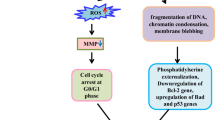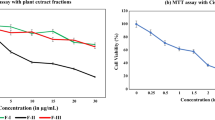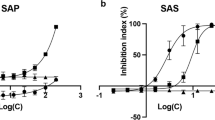Abstract
Java Ginger or Curcuma zanthorrhiza Roxb. has long gained focus among tribal people of Java, for its medicinal properties mainly against gynaecological challenges. The present study aims to identify the most potent phytocompound present in the extract and determine primary mode of action accountable for cytotoxic activity of Curcuma zanthorrhiza rhizome extract against HPV16-positive SiHa cervical cancer cells. The phytochemically-rich extract of rhizome (CZM) was capable to inhibit proliferation of target cells in a dose-dependent manner with an IC50 of 150 μg/ml. Dysregulation of intercellular antioxidant defence system resulted to surges in ROS and RNS level, increased calcium concentration and compromised mitochondrial membrane potential. Nucleus got affected, cell cycle dynamics got impaired while clonogenicity and migration ability diminished. Expression of viral oncogenes E7 and E6 decreased significantly. Accumulation of toxic cell metabolite and decrease in level of essential ones continued. Finally, alteration in PI3K/AKT/mTOR signalling route was followed by onset of autophagic cell death concomitant with the upregulated expression of Beclin1, Atg5-12 and LC3II. Curcumin and a novel crystal as well as few phyto-fractions were isolated by column chromatography. Of these, curcumin was found to be most potent in inducing cytotoxicity in SiHa while two other fractions also showed significant activity. Thus, CZM acted against SiHa cells by inducing autophagy that commences in compliance to the changes in PI3K/AKT/mTOR pathway mainly in response to oxidative stress. To the best of our knowledge this is the first report of Curcuma zanthorrhiza Roxb. inducing autophagy.












Similar content being viewed by others
Data availability
Data will be available on reasonable request to corresponding author.
References
Ajanal M, Gundkalle MB, Nayak SU (2012) Estimation of total alkaloid in Chitrakadivati by UV-Spectrophotometer. Ancient Sci. Life 31:198–201. https://doi.org/10.4103/0257-7941.107361
Anderson G (2019) Breast cancer: occluded role of mitochondria N-acetylserotonin/melatonin ratio in co-ordinating pathophysiology. Biochem Pharmacol 168:259–268. https://doi.org/10.1016/j.bcp.2019.07.014
Anderson G (2020) Tumour microenvironment: roles of the aryl hydrocarbon receptor, O-GlcNAcylation, acetyl-CoA and melatonergic pathway in regulating dynamic metabolic interactions across cell types-tumour microenvironment and metabolism. Int J Mol Sci 22(1):141. https://doi.org/10.3390/ijms22010141
Anthon GE, Barrett DM (2003) Modified method for the determination of pyruvic acid with dinitrophenylhydrazine in the assessment of onion pungency. J Sci Food Agric 83(12):1210–1213. https://doi.org/10.1002/jsfa.1525
Arnér ES, Holmgren A (2000) Physiological functions of thioredoxin and thioredoxin reductase. Eur J Biochem. 267(20):6102–6109. https://doi.org/10.1046/j.1432-1327.2000.01701.x
Bachmeier BE, Killian PH, Melchart D (2018) The role of curcumin in prevention and management of metastatic disease. Int J Mol Sci 19(6):1716. https://doi.org/10.3390/ijms19061716
Borshchevskaya LN, Gordeeva TL, Kalinina AN, Sineokii SP (2016) Spectrophotometric determination of lactic acid. J Anal Chem 71(8):755–758. https://doi.org/10.1134/S1061934816080037
Broadhurst RB, Jones WT (1978) Analysis of condensed tannins using acidified vanillin. J Sci Food Agric 29:788–794. https://doi.org/10.1002/jsfa.2740290908
Chang YC, Hsieh MC, Wu HJ, Wu WC, Kao YH (2015) Methylglyoxal, a reactive glucose metabolite, enhances autophagy flux and suppresses proliferation of human retinal pigment epithelial ARPE-19 cells. Toxicol in Vitro 29(7):1358–1368. https://doi.org/10.1016/j.tiv.2015.05.014
Chiruvella KK, Panjamurthy K, Choudhary B, Joy O, Raghavan SC (2010) Methyl angolensate from callus of Indian redwood induces cytotoxicity in human breast cancer cells. Int J Biomed Sci 6(3):182. https://doi.org/10.1016/j.febslet.2008.11.001
Christ B, Müller KH (1960) Zur serienmäßigen Bestimmung des gehaltes an flavonol-derivaten in drogen. Arch Pharm 293(12):1033–1042
Corns CM, Ludman CJ (1987) Some observations on the nature of the calcium-cresolphthalein complexone reaction and its relevance to the clinical laboratory. Ann Clin Biochem 24(4):345–351. https://doi.org/10.1177/000456328702400403
Dafre AL, Schmitz AE, Maher P (2017) Methylglyoxal-induced AMPK activation leads to autophagic degradation of thioredoxin 1 and glyoxalase 2 in HT22 nerve cells. Free Radic Biol Med 108:270–279. https://doi.org/10.1016/j.freeradbiomed.2017.03.028
Deiana M, Aruoma OI, Maria de Lourdes PB, Spencer JP, Kaur H, Halliwell B, Aeschbach R, Banni S, Dessi MA, Corongiu FP (1999) Inhibition of peroxynitrite dependent DNA base modification and tyrosine nitration by the extra virgin olive oil-derived antioxidant hydroxytyrosol. Free Radic Biol Med 26(5–6):762–769. https://doi.org/10.1016/s0891-5849(98)00231-7
Franken NA, Rodermond HM, Stap J, Haveman J, Van Bree C (2006) Clonogenic assay of cells in vitro. Nat Protoc 1(5):2315–2319. https://doi.org/10.1038/nprot.2006.339
Gan ZR, Wells WW (1986) Purification and properties of thioltransferase. J Biol Chem 261(3):996–1001. https://doi.org/10.1016/S0021-9258(17)36043-X
Ghorai N, Chakraborty S, Gucchait S, Saha SK, Biswas S (2012) Estimation of total terpenoids concentration in plant tissues using a monoterpene, linalool as standard reagent. Protoc Exch. https://doi.org/10.1038/protex.2012.055
Hummel JP (1949) The fluorometric determination of malic acid. J Biol Chem 180(3):1225–1228. https://doi.org/10.1016/S0021-9258(19)51235-2
Ismail N, Pihie AHL, Nallapan M (2005) Xanthorrhizol induces apoptosis via the up-regulation of bax and p53 in HeLa cells. Anticancer Res 25(3B):2221–2227
Jantan I, Rohani AS, Sumantri IB (2021) Immunomodulatory effects and mechanisms of curcuma species and their bioactive compounds: A review. Front Pharmacol 12:643119. https://doi.org/10.3389/fphar.2021.643119
Javed MH, Azimuddin SM, Hussain AN, Ahmed A, Ishaq M (1997) Purification and characterization of lactate dehydrogenase from Varanus liver. Exp Mol Med 29(1):25–30. https://doi.org/10.1016/0305-0491(94)00230-r
Kim AJ, Kim YO, Shim JS, Hwang JK (2007) Immunostimulating activity of crude polysaccharide extract isolated from Curcuma xanthorrhiza Roxb. Biosci Biotechnol Biochem 71(6):1428–1438. https://doi.org/10.1271/bbb.60241
Koundouros N, Poulogiannis G (2020) Reprogramming of fatty acid metabolism in cancer. Br J Cancer 122(1):4–22. https://doi.org/10.1038/s41416-019-0650-z
Li B, Sui L (2021) Metabolic reprogramming in cervical cancer and metabolomics perspectives. Nutr Metab 18(1):1–14. https://doi.org/10.1186/s12986-021-00615-7
Liang CC, Park AY, Guan JL (2007) In vitro scratch assay: a convenient and inexpensive method for analysis of cell migration in vitro. Nat Protoc 2(2):329–333. https://doi.org/10.1038/nprot.2007.30
Lin CH, Chou CC, Lee YH, Hung CC (2022) Curcumin facilitates aryl hydrocarbon receptor activation to ameliorate inflammatory astrogliosis. Molecules 27(8):2507. https://doi.org/10.3390/molecules27082507
Majumder I, Paul S, Nag A, Kundu R (2020) Chloroform fraction of Chaetomorpha brachygona, a marine green alga from Indian Sundarbans inducing autophagy in cervical cancer cells in vitro. Sci Rep 10(1):1–12. https://doi.org/10.1038/s41598-020-78592-9
Mannervik B (1999) Measurement of glutathione reductase activity. Curr Protoc Toxicol 1:7–2. https://doi.org/10.1002/0471140856.tx0702s00
Mauthe M, Orhon I, Rocchi C, Zhou X, Luhr M, Hijlkema KJ, Coppes RP, Engedal N, Mari M, Reggiori F (2018) Chloroquine inhibits autophagic flux by decreasing autophagosome-lysosome fusion. Autophagy 14(8):1435–1455. https://doi.org/10.1080/15548627.2018.1474314
Mesquita CS, Oliveira R, Bento F, Geraldo D, Rodrigues JV, Marcos JC (2014) Simplified 2, 4-dinitrophenylhydrazine spectrophotometric assay for quantification of carbonyls in oxidized proteins. Anal Biochem 458:69–71. https://doi.org/10.1016/j.ab.2014.04.034
Mosmann T (1983) Rapid colorimetric assay for cellular growth and survival: application to proliferation and cytotoxicity assays. J Immunol Methods. 65(1–2):55–63. https://doi.org/10.1016/0022-1759(83)90303-4
Mustacich D, Powis G (2000) Thioredoxin reductase. Biochem J 346(1):1–8
Nag A, Verma P, Paul S, Kundu R (2022) In silico analysis of the apoptotic and HPV inhibitory roles of some selected phytochemicals detected from the rhizomes of greater cardamom. Appl Biochem Biotechnol. https://doi.org/10.1007/s12010-022-04006-3
Pal A, Sengupta S, Kundu R (2021) Tiliacora racemosa leaves induce oxidative stress mediated DNA damage leading to G2/M phase arrest and apoptosis in cervical cancer cells SiHa. J Ethnopharmacol 269:113686. https://doi.org/10.1016/j.jep.2020.113686
Paul S, Patra D, Kundu R (2019) Lignan enriched fraction (LRF) of Phyllanthus amarus promotes apoptotic cell death in human cervical cancer cells in vitro. Sci Rep 9(1):1–14. https://doi.org/10.1038/s41598-019-51480-7
Perillo B, Di Donato M, Pezone A, Di Zazzo E, Giovannelli P, Galasso G, Castoria G, Migliaccio A (2020) ROS in cancer therapy: The bright side of the moon. Exp Mol Med 52(2):192–203. https://doi.org/10.1038/s12276-020-0384-2
Pour LM, Farahnak A, Rad MM, Golmohamadi T, Eshraghian M (2014) Activity assay of glutathione S-transferase (GSTs) enzyme as a diagnostic biomarker for liver hydatid cyst in vitro. Iran J Public Health 43(7):994
Singleton VL, Rossi JA (1965) Colorimetry of total phenolics with phosphomolybdic-phosphotungstic acid reagent. Am J Enol Vitic 16:144–158
Su LJ, Zhang JH, Gomez H, Murugan R, Hong X, Xu D, Jiang F, Peng ZY (2019) Reactive oxygen species-induced lipid peroxidation in apoptosis, autophagy, and ferroptosis. Oxidat Med Cell Longev. https://doi.org/10.1155/2019/5080843
Thomé MP, Filippi-Chiela EC, Villodre ES, Migliavaca CB, Onzi GR, Felipe KB, Lenz G (2016) Ratiometric analysis of Acridine Orange staining in the study of acidic organelles and autophagy. J Cell Sci 129(24):4622–4632. https://doi.org/10.1242/jcs.195057
Townsend DM, Tew KD (2003) The role of glutathione-S-transferase in anti-cancer drug resistance. Oncogene 22(47):7369–7375. https://doi.org/10.1038/sj.onc.1206940
Vernis L, El Banna N, Baille D, Hatem E, Heneman A, Huang ME (2017) Fe-S clusters emerging as targets of therapeutic drugs. Oxidat Med Cell Longev. https://doi.org/10.1155/2017/3647657
Veskoukis AS, Margaritelis NV, Kyparos A, Paschalis V, Nikolaidis MG (2018) Spectrophotometric assays for measuring redox biomarkers in blood and tissues: the NADPH network. Redox Rep 23(1):47–56. https://doi.org/10.1080/13510002.2017.1392695
Wang J, Mijiti Y, Chen Y, Liu Z (2021) Aryl hydrocarbon receptor is a prognostic biomarker and is correlated with immune responses in cervical cancer. Bioengineered 12(2):11922–11935. https://doi.org/10.1080/21655979.2021.2006953
Wild R, Ooi L, Srikanth V, Münch G (2012) A quick, convenient and economical method for the reliable determination of methylglyoxal in millimolar concentrations: the N-acetyl-L-cysteine assay. Anal Bioanal Chem Res 403(9):2577–2581. https://doi.org/10.1007/s00216-012-6086-4
Wu D, Yotnda P (2011) Production and detection of reactive oxygen species (ROS) in cancers. JoVE (J Vis Exp) 21(57):e3357. https://doi.org/10.3791/3357
Yang Y, Chan WK (2021) Glycogen synthase kinase 3 beta regulates the human aryl hydrocarbon receptor cellular content and activity. Int J Mol Sci 22(11):6097. https://doi.org/10.3390/ijms22116097
Ali SA, Khalil NY, Ahmed S, Rehmani FS, Yaqoob M and Yasinzai MM, (1998). Studies on the photometric estimation of citrate in urine. Pak J Biol Sci. 1998. https://scialert.net/abstract/?doi=pjbs.1998.326.328.
Ervintari F, Puspitawati R, Utami S (2019) Effect of Curcuma Xanthorrhiza Roxb ethanol extract on the viability of Streptococcus mutans and Streptococcus sanguinis dual-species biofilms. Int J Pharm https://doi.org/10.22159/ijap.2019.v11s1.181.
Flohé L, Günzler WA (1984) Assays of glutathione peroxidase. In Methods in enzymology 105, 114–120. Academic Press. https://doi.org/10.1016/s0076-6879(84)05015-1.
Jiao Y, Wang Y, Guo S, Wang G (2017) Glutathione peroxidases as oncotargets. Oncotarget. 8(45): 80093. https://doi.org/10.18632/oncotarget.20278.
Sestili P, Calcabrini C, Diaz AR, Fimognari C, Stocchi V (2017) The fast-halo assay for the detection of DNA damage. In Fast Detection of DNA Damage (75–93). Humana Press, New York, NY. https://doi.org/10.1007/978-1-4939-7187-9_6
Setyati WA, Subagiyo S, Pramesti R, Pringgenies D (2019) Effectiveness of herbal extract (Piper retrofractum, Curcuma aeruginosa, and Curcuma zanthorrhiza) as immunomodulator in non-specific immunity system of tiger grouper (Epinephelus fuscoguttatus) against infection from Vibrio alginolyticus and Vibrio parah. Sci Technol Indones 4(4):94–100. https://doi.org/10.26554/sti.2019.4.4.94-100.
Sivandzade F, Bhalerao A, Cucullo L (2019). Analysis of the mitochondrial membrane potential using the cationic JC-1 dye as a sensitive fluorescent probe. Bio-protoc. 9(1):e3128 https://doi.org/10.21769/BioProtoc.3128
Zhang X, Cheng X, Yu L, Yang J, Calvo R, Patnaik S, Hu X, Gao Q, Yang M, Lawas M, Delling M (2016) MCOLN1 is a ROS sensor in lysosomes that regulates autophagy Nat Commun 7(1), 1–12. https://doi.org/10.1038/ncomms12109.
Rahmat E, Lee J, Kang Y (2021) Javanese turmeric (Curcuma xanthorrhiza Roxb.): ethnobotany, phytochemistry, biotechnology, and pharmacological activities. Evid-Based Complement Altern Med 2021:9960813
Mehrotra R, Yadav K (2022) Cervical Cancer: formulation and implementation of Govt of India guidelines for screening and management. Indian J Gynecol Oncol 20(1):1–8. https://doi.org/10.1007/s40944-021-00602-z
Acknowledgements
SN would like to acknowledge Prof. Mamiyil Sabu, University of Calicut for kindly providing the rhizome of Curcuma zanthorrhiza Roxb. SAIF-IIT Bombay is acknowledged for HRLCMS analyses, University of Calcutta’s CRNN for allowing use of flow cytometer, DBT-IPLS facility for confocal microscope, UGC-UPE facility for gel-documentation unit. SN would like to thank all the former and present research scholars from Advanced Cell Biology Laboratory, Department of Botany, University of Calcutta, for their help. This work was supported by University Grants Commission-Universities with Potential for Excellence (UGC-UPE)-II, Grant number: UGC/144/UPE/ST1 (20.03.17). SN thanks the University Grants Commission, Government of India for her fellowship.
Author information
Authors and Affiliations
Contributions
SN and RK conceived the work. SN carried out the experiments and curated data. DP conducted NMR and helped with NMR and XRD analyses. AN conducted GCMS procedure and SN analysed the data. SN wrote the manuscript. RK assessed and confirmed the manuscript.
Corresponding author
Ethics declarations
Conflict of interest
The authors declare that they have no known competing interests.
Supplementary Information
Below is the link to the electronic supplementary material.
Rights and permissions
Springer Nature or its licensor (e.g. a society or other partner) holds exclusive rights to this article under a publishing agreement with the author(s) or other rightsholder(s); author self-archiving of the accepted manuscript version of this article is solely governed by the terms of such publishing agreement and applicable law.
About this article
Cite this article
Nath, S., Patra, D., Nag, A. et al. Sesquiterpenoid-rich Java Ginger rhizome extract prompts autophagic cell death in cervical cancer cell SiHa mainly by modulating cellular redox homeostasis. 3 Biotech 13, 8 (2023). https://doi.org/10.1007/s13205-022-03415-9
Received:
Accepted:
Published:
DOI: https://doi.org/10.1007/s13205-022-03415-9




